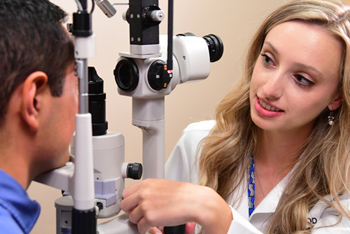Glaucoma is referred to as “the silent thief of sight.” This stealthy eye disease often exhibits no noticeable symptoms until irreversible damage has already taken place. But the good news is that the disease can, in most cases, effectively be managed with medicine or certain procedures to prevent any further vision loss. In fact, the number of treatments is growing and changing faster than ever before. Although January is Glaucoma Awareness Month, it’s important to shed light on this sight-stealing disease all year long.
What exactly is glaucoma?
Glaucoma is the buildup of fluid in the eye (usually the front part of the eye) due to improper drainage, which often results in increased eye pressure. That pressure eventually causes damage to the optic nerve if left untreated. The optic nerve is responsible for sending the images we see to the brain, so when it’s damaged, the images become distorted. Although eye pressure is indeed a risk factor, we now know that other factors are also involved because even people with “normal” IOP (intraocular pressure) can experience vision loss due to glaucoma.
What are the different types of glaucoma?
There are two major types of glaucoma – primary open-angle glaucoma and angle-closure glaucoma. The most common form of glaucoma is primary open-angle glaucoma, which affects about three million Americans on average. It occurs when the necessary amount of fluid is unable to drain from the eye, which in turn raises the IOP. Most people have no symptoms or early warning signs, but if not treated, it can cause gradual loss of vision.
Katheryn Kibler, O.D., of EyeCare Optical explains what she is on the lookout for when screening her patients for this silent disease.

“In terms of warning signs for glaucoma, open-angle glaucoma, which is the most common form, unfortunately has no early warning signs that a patient could be aware of,” Dr. Kibler said. “The two biggest things I look at when monitoring for glaucoma are eye pressure and optic nerve health/appearance. There are also many other factors to consider, including family history, corneal thickness, age, race, visual fields, and anterior chamber angle evaluation. With rare exception, such as in the case of an angle-closure attack where pressures can spike significantly, eye pressure is not something we can feel when it is elevated.”
It’s that elevated eye pressure that can damage the optic nerve over time. Luckily, open-angle glaucoma usually responds well to medication, especially if caught early and treated promptly.
In the case of angle-closure glaucoma, this happens when a person’s iris is very close to the drainage angle in their eye. The iris can end up blocking the drainage angle, and when it becomes completely blocked, eye pressure rises very quickly. This is called an acute attack. When this occurs, you should seek emergency medical help immediately as it can result in blindness.
Signs of an acute attack include:
- Severe eye pain
- Vision suddenly becomes blurry
- Headache
- Nausea
- Vomiting
- Seeing rainbow-colored rings or halos around lights
How Is Glaucoma Treated?
Glaucoma can usually be effectively treated with medicine, laser surgery, or filtration surgery. It is a chronic disease that requires lifelong treatment. However, many experts agree that there is much happening in modern research that raises hope for a cure sometime in the not-too-distant future. But in the meantime, preventing any future damage from occurring is the main goal for eye care professionals.
“Glaucoma cannot be cured; however, our goal is to lower the eye pressure to halt and prevent any future damage from occurring,” Dr. Kibler said. “We usually use eyedrops to accomplish this, but there are in-office laser procedures and surgical options as well. In the past few years there have been some very exciting new advances in glaucoma therapy with the release of new eyedrops for lowering eye pressure. There is always continued work in the field for new devices and treatment options coming out in the future.”
Early detection is the best defense against glaucoma.
Glaucoma can occur at any age. However, it remains one of the leading causes of blindness in people over 60. The chances of developing the disease increase for people who are African American or Hispanic; have a family history; are extremely nearsighted; have diabetes, hypertension, and/or any vascular diseases.
“When damage occurs to the optic nerve it takes away our vision starting in the periphery. In general, this is a slow, gradual process,” Dr. Kibler explained. “Because of this, we are not aware of the gradual changes that can take place to our vision over time. This is why it is so important to have regular eye exams to detect any early changes. Early diagnosis is key for glaucoma.”
What’s the next step in getting screened for glaucoma in East Tennessee?
No matter what your concerns are regarding your precious vision, the board-certified Optometrists and Ophthalmologists at EyeCare Optical, a division of Drs. Campbell, Cunningham, Taylor & Haun, are standing by ready to offer personal care and state-of-the-art technology to screen for, diagnose, and treat a myriad of eye diseases, including glaucoma. To schedule your appointment, call us at (865) 584-0905.


